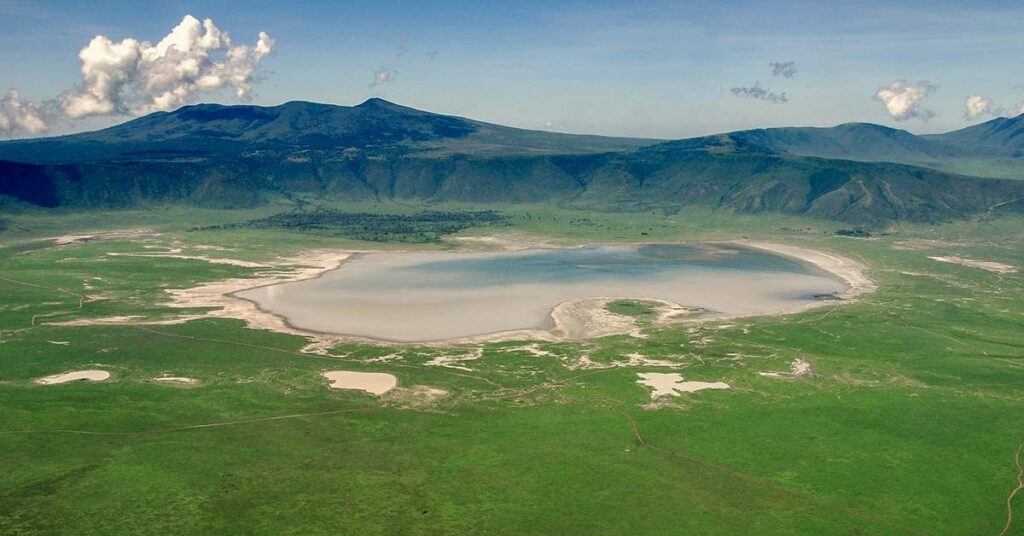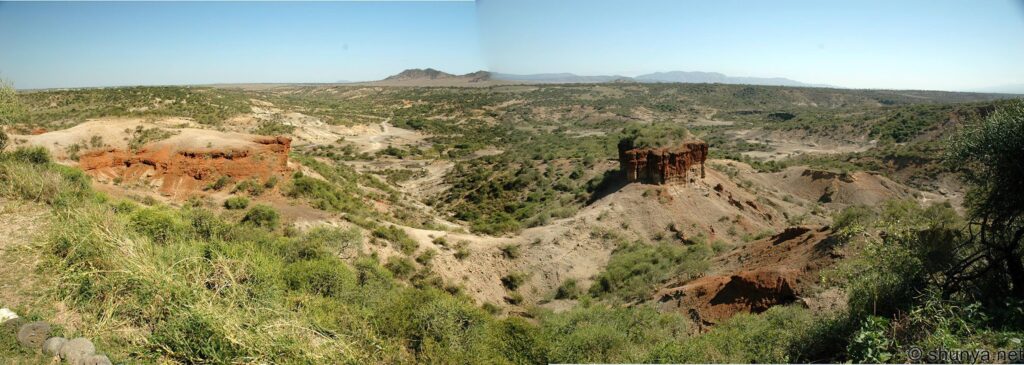Ngorongoro Conservation Area
Ngorongoro Crater and Conservation Area is a remarkable destination, home to Africa’s Big Five and the world’s largest intact volcanic caldera. This stunning location features fantastic cats, large tusker elephants, and a significant population of black rhinos.
The Ngorongoro Crater, located in northern Tanzania, is one of Africa’s most famous parks. This ancient volcano, once as tall as Kilimanjaro, erupted two to three million years ago, creating the world’s biggest intact crater with 600m-high walls. The volcanic soil’s richness and year-round water supply have attracted one of Africa’s largest wildlife populations, making Ngorongoro a truly magnificent place with some of the best wildlife sightings of any safari destination.
The Ngorongoro Crater is renowned as one of Africa’s premier wildlife viewing destinations.It is home to an estimated 24,000 large mammals, including waterbucks, African leopards, black rhinos, buffaloes, cheetahs, crocodiles, East African wild dogs, elands, Grant’s gazelles, zebras, hippopotamuses, impalas, lions, oribis, Thomson’s gazelles, topis, and wildebeests. Most of these animals reside permanently within the natural enclosure of the crater, leading to minimal migration, except for a few wildebeests and elephants. This restricted movement has resulted in significant inbreeding among some species, such as lions.
Wildlife thrives not only within the Ngorongoro Crater but also throughout the broader Ngorongoro Conservation Area. The region around Ndutu Lake, for instance, supports robust populations of lions and cheetahs, alongside other species like jackals, spottedhyenas, wild dogs, and servals. The Ngorongoro Conservation Area also plays a crucial rolein the famous Great Migration of East Africa. Every December, around 1.6 million wildebeests, 450,000 zebras, and 265,000 gazelles migrate through the area from the south, only to return north in June.

Empakai Crater: A Hidden Gem Within Ngorongoro Conservation Area
Empakai Crater is one of the lesser-known yet equally fascinating features within the Ngorongoro Conservation Area. Unlike the more famous Ngorongoro Crater, Empakai is a smaller, water-filled caldera that offers visitors a tranquil and secluded environment. The crater’s floor is dominated by a deep soda lake, which occupies nearly half of the crater’s base. This lake, with its alkaline waters, attracts a variety of waterbirds, including flamingos, which create a striking visual contrast against the lush, green walls of the caldera.
Hiking down to the crater lake is a popular activity for visitors. The trail offers breathtaking views of the surrounding landscape and an opportunity to experience the area’s diverse flora and fauna up close. The steep walls of the crater are covered in dense forest, home to animals such as buffaloes, bushbucks, and various primates. The serene environment makes it a perfect spot for birdwatching and nature photography. Moreover, the hike provides an excellent chance to learn about the region’s geological history, as the crater was formed by volcanic activity millions of years ago.

Oldoinyo Lengai: The Sacred Mountain of God
Oldoinyo Lengai, which translates to “Mountain of God” in the Maasai language, is an active stratovolcano located to the north of the Ngorongoro Conservation Area. It is the only known active volcano that erupts natrocarbonatite lava, which is significantly cooler than typical basaltic lava and has a unique, almost black color when it erupts, turning white upon exposure to the atmosphere. This unusual type of lava creates distinct and fascinating landscapes that draw geologists and adventurers from around the world.
Climbing Oldoinyo Lengai is a challenging yet rewarding experience. The ascent is steep and strenuous, often undertaken at night to avoid the extreme heat of the day.
However, those who reach the summit are rewarded with spectacular views of the surrounding Rift Valley, including the expansive plains of the Serengeti and the shimmering waters of Lake Natron. The summit itself offers a close-up view of the active crater, with its steaming vents and occasional lava flows, providing a rare glimpse into the dynamic processes shaping the Earth’s crust.
Oldoinyo Lengai holds cultural significance for the local Maasai people, who regard it as a sacred site. The mountain is often involved in traditional rituals and ceremonies, and visitors may learn about the rich cultural heritage and beliefs associated with this natural wonder.

Olduvai Gorge: The Cradle of Humankind
Olduvai Gorge, located between the Ngorongoro Crater and the Serengeti Plains, is one of the world’s most important paleoanthropological sites. Often referred to as the “Cradle of Mankind,” Olduvai Gorge has provided crucial insights into human evolution and prehistoric life. The gorge was brought to international prominence by the pioneering work of Louis and Mary Leakey, who uncovered some of the earliest evidence of human ancestors, including fossils of Homo habilis and Australopithecus boisei.
The geological strata of Olduvai Gorge span millions of years, preserving a record of ancient environments and the creatures that lived in them. This includes not only hominin fossils but also bones of extinct animals and ancient stone tools, which provide a comprehensive picture of early human life. The findings from Olduvai have helped scientists understand the development of human bipedalism, tool use, and other fundamental aspects of our evolutionary history.
Visitors to Olduvai Gorge can explore a small museum that houses many of the important discoveries made in the area. The museum offers detailed exhibits on the Leakey family’s work, the various hominin species found at the site, and the significance of these discoveries in the broader context of human evolution. Guided tours of the gorge allow visitors to see the actual excavation sites and gain a deeper appreciation of the meticulous work involved in unearthing our ancient past. For those interested in anthropology, archaeology, or history, Olduvai Gorge is a compelling destination that vividly illustrates the story of human origins.
Together, Empakai Crater, Oldoinyo Lengai, and Olduvai Gorge represent the rich natural and cultural heritage of the Ngorongoro Conservation Area. Each site offers unique insights into the region’s geology, biodiversity, and the history of human evolution, making them invaluable resources for both education and adventure.
Key Highlights:
Africa's Big Five
The crater is one of the best spots in Africa to see the Big Five (buffalo, lion, leopard, elephant, and rhino). It hosts over 70 lions, large buffalo herds, 40 rhinos, and some of the biggest tusker elephants. Leopards, though elusive, can be spotted in the Lerai Forest and occasionally on the Crater rim.
Diverse Wildlife
Apart from the Big Five, the crater is home to Grant’s and Thomson’s gazelles, eland, topi, spotted hyena, hartebeest, jackal, baboon, warthog, wildebeest, and zebra. The soda lake attracts hippopotamus and waterbuck, while the higher regions house mountain reedbuck, Cape buffalo, and elephant.
Rich Birdlife
With over 200 bird species, including large flocks of flamingos in the soda lake, raptors like the marsh harrier, and various other species, the crater is a birdwatcher’s paradise.
Maasai Culture
The Maasai people live in the area, coexisting with the wildlife and maintaining their traditional way of life. Visitors can interact with the Maasai and learn about their culture and traditions.
Scenic Views
The crater offers stunning panoramic views, with the crater floor providing a breathtaking backdrop for wildlife encounters.
